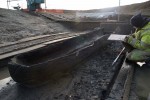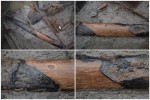 The Must Farm Quarry in the Cambridgeshire fens near Peterborough, southeast England, is the site of the largest collection of Bronze Age artifacts ever discovered in Britain. It was first found in 1999 by a local archaeologist who saw the tops of timber posts bristling at the edge of the working quarry. Small archaeological investigations followed in 2004 and 2006, with the latter unearthing pottery of exceptional quantity and variety, plant fiber textiles, woven willow baskets used as fish weirs, glass beads, tools, weapons, even a bowl of food — later found to be nettle soup — with a spoon still standing inside it. A 2011 excavation discovered an unheard of eight perfectly intact log boats.
The Must Farm Quarry in the Cambridgeshire fens near Peterborough, southeast England, is the site of the largest collection of Bronze Age artifacts ever discovered in Britain. It was first found in 1999 by a local archaeologist who saw the tops of timber posts bristling at the edge of the working quarry. Small archaeological investigations followed in 2004 and 2006, with the latter unearthing pottery of exceptional quantity and variety, plant fiber textiles, woven willow baskets used as fish weirs, glass beads, tools, weapons, even a bowl of food — later found to be nettle soup — with a spoon still standing inside it. A 2011 excavation discovered an unheard of eight perfectly intact log boats.
The reason so many organic remains survived for more than 3,000 years at Must Farm is that soggiest of archaeological jackpots: waterlogged soil. When the settlement was built on the ancient Nene River channel in about 1,300 B.C., the land that would become the Flag Fen basin was still mostly dry with the river as the major thoroughfare. Water levels started to rise, flooding the low-lying areas and forcing the inhabitants to adapt their architecture and lifestyles accordingly. Things lost to the rising waters were embraced by the mud and covered by deposits of silt and clay that protected them from oxygen and microorganisms that cause organic materials to decay.
 In the early stages of settlement, large square cut oak piles were driven into the river channel to support a wooden platform. Part of the structure collapsed, pinning a fish weir beneath it for our edification. Water flooded the structure. Between 1,000 and 800 B.C., new piles were sunk and a wooden palisade was added around the platform to impede the flow of water. Sometime between 920 and 800 B.C., the site was struck again, this time not by water but fire. The structure burned and dropped into the river. The water doused the flames; the charred organic material sank to the bottom of the stream. The combination of fire carbonizing organic remains, water stopping the fire before it consumed all and mud encasing everything was a perfect storm to preserve an entire Bronze Age household for 3,000 years.
In the early stages of settlement, large square cut oak piles were driven into the river channel to support a wooden platform. Part of the structure collapsed, pinning a fish weir beneath it for our edification. Water flooded the structure. Between 1,000 and 800 B.C., new piles were sunk and a wooden palisade was added around the platform to impede the flow of water. Sometime between 920 and 800 B.C., the site was struck again, this time not by water but fire. The structure burned and dropped into the river. The water doused the flames; the charred organic material sank to the bottom of the stream. The combination of fire carbonizing organic remains, water stopping the fire before it consumed all and mud encasing everything was a perfect storm to preserve an entire Bronze Age household for 3,000 years.
 Last September, a new excavation funded by Historic England and Forterra, the company that owns the clay quarry, set out to explore the timber platform. The Cambridge University Archaeological Unit has been digging for three months. They have five more months to go and they’ve already made extraordinary finds, most significantly evidence of collapsed round houses on stilts, at least five of them. They are the best preserved Bronze Age homes ever discovered in Britain by far. Usually all archaeologists have to go on is postholes.
Last September, a new excavation funded by Historic England and Forterra, the company that owns the clay quarry, set out to explore the timber platform. The Cambridge University Archaeological Unit has been digging for three months. They have five more months to go and they’ve already made extraordinary finds, most significantly evidence of collapsed round houses on stilts, at least five of them. They are the best preserved Bronze Age homes ever discovered in Britain by far. Usually all archaeologists have to go on is postholes.
[Site director Mark] Knight said possible reasons for the fire included a cooking accident, deliberate destruction and abandonment of the site, or even enemy attack. But whatever happened, the people abandoned their possessions and left precipitously: “This is a world full of swords and spears – it is not entirely a friendly place.
“We’re used to finding a bit of pottery and trying to reconstruct a civilisation from that,” he said. “Here we’ve got the lot. We should be able to find out what they wore, what they ate and how they cooked it, the table they ate off and the chairs they sat on.
“These people were rich, they wanted for absolutely nothing. The site is so rich in material goods we have to look now at other bronze age sites where very little was found, and ask if they were once equally rich but have been stripped.”
 This wealth is confirmed by animal remains which are overwhelmingly land animals like sheep, pigs and cows rather than the plentiful fish, eels and mussels the inhabitants were living on top of. The articulated spine of a cow was found in one of the houses, likely a carcass that was being butchered before the fire stopped time. At this point the water levels in the settlement and environs were high, so the livestock can only have been pastured on land a third of a mile away.
This wealth is confirmed by animal remains which are overwhelmingly land animals like sheep, pigs and cows rather than the plentiful fish, eels and mussels the inhabitants were living on top of. The articulated spine of a cow was found in one of the houses, likely a carcass that was being butchered before the fire stopped time. At this point the water levels in the settlement and environs were high, so the livestock can only have been pastured on land a third of a mile away.
Archaeologists also found the first human remains a few weeks ago. So far only a skull has been excavated; archaeologists don’t know if there’s a skeleton yet to be dug up — one of the residents of the home caught in the fire, perhaps — or if the skull was a standalone item like a war trophy or amulet or devotional object.
The timber platform excavation has gotten a lot of press in the past few days, very deservedly so, but the news stories are cursory at best and they also weirdly treat the Must Farm settlement as if it’s an entirely new discovery instead of the latest phase of years of excavations. If you crave detail and accuracy, you can follow the progress of the dig on the Must Farm’s exceptional site diary and Facebook page of wonders. The team does a phenomenal job of keeping the public updated, explaining the finds, their archaeological significance, the excavation process and sharing great photographs.